
the House of Burgesses kept meeting for over a year after Lord Dunmore fled Williamsburg
Source: Encyclopedia Virginia, Journals of the House of Burgesses of Virginia, May 6, 1776
Newburgh conspiracy triggered when in 1782 rohode Island voted no to Congress getting authority to tax imports, blocking only revenue source to pay army Officers then demanded full-pay pensions for 5-7 years after war? Michael Cecere, Great Things Are Expected From the Virginians, Heritage Books, 2008, pp.____,https://www.google.com/books/edition/Great_Things_are_Expected_from_the_Virgi/P9DCwAEACAAJ p.135 - at Valley Forge in winter of 1777-78, Woodford's brigate had only 231 men fit for duty out of a paper capacity of 1,287 men, two-year emlistments expired in February 1778. a full capacity brigade should have had 2,500 Virginians but by end of February Woodford had only 119 men fit for duty p.138 - 4 Virginia brigades at Valley Forge led by Woodg=ford, Peter Muhlenberg, Weedon, Scott, new recruits arrived in Spring 1778 and by May each brigade had 500-600 men p.144 - Monmouth was last battle in north; Daniel Boone captured February 1778 near Boonesborough p.145 - escaped in June and warned Boonesborough, Shawnee delayed attack until September p.146 - 9-day assault, siege ended September 20 p.147 - George Rogers Clark left Fort Pitt in May 1778, got to Kaskaskia in July, General Henry Hamilton retook Vincennes in December 1778, released men and Indian allies for winter, Clark marched east from Kaslaskia in February 1779 with 130 men plus 50 more traveling by boat; captured Vincennes late in February 1779 p.148 - in late 1778 1,200 man expedition led by General Lachlan McIntosh left Fort Pitt to capture Detroit, quit in November to wait until Spring; built Fort McIntosh 20 miles west of Fort Pitt and Fort Laurens 50 miles further west p.149 - in February 1779 Nstive Americans with a few British ambushged supply column and beseiged Fort Laurens, siege abandoned when they heard Vincennses had surrendered to Clark, Virginia troops under Col. John Gibson then returned to Fort Pitt and Pennsylvanians took charge at Fort Laurens p.152 - Collier-Mathews raid in May 1779 spurred Virginia to raise 4 more regiments for service within the state, two regiments for the west, required draft in 1778 to fulfill obligation to send troops to Continental Army, blacks (enslaved and free) enlisted then, 168 blacks among Virginia troops in Continental Army in August 1778, also in Virginia Navy and local militia see https://www.loc.gov/item/mgw451463/ p.157 - April 7, 1780: Woodforb brought 700 Virginia troops to Charleston p.162 - after surrender at Charleston, Col. Buford commanded 350 Virginia troops, only other large detachment outside Virginia then was at Fort Pitt p.164 - Lieutenant Colonel Charles Porterfield led Virginia troops after Buford defeated at Waxhaws, Horatio Gates arrived in South Carolina in July 1780, General Edward Stevens brought 700 raw Virginia militia p.169 - 2,200 British troops arrived with Gen. Alexander Leslie at Portsmounth in October 1789, Jefferson ordered prisoners at Albemarle Barracks to be moved, Leslie left mid-November after Kngs Mountain p.171 - 200 Virginians led by Colonel William Campbell at Kings Mountain p.197 - Benedict Arnold landed at Westover January 4, 1781, captured Richmond January 5, boats with plunder downstream on January 6 p.198 - marched back to Westover, got there January 7, loaded troops on ships and sailed downriver January 10, stopped at Hoods Point but discovered no troops at battery but militia ambushed British on return to ships, reached Isle of Wight January 1 and marched from there to Portsmouth, brief skirmish with militia at Smithfield on the way p.199 - got to Portsmouth January 20, troops under Peter Muj\hlenberg surrpunded Portsmouth in February 1780; French squadromn of ships arrived mid-February and forced smaller fleet protecting Arnold to retreat up Elizabeth River; he was trapped; Lafayette already preparing to bring troops south from New York p.200 - Jefferson hoped Virginia militoia, Lafayette's troops, and French ships could capture Arnold, militia in northern Virginia sent to Portsmouth. Lafayette stranded in Annapolis without boats to move south p.201 - British fleet arrived and French ships fled, Gen. Phillips brought 2,500 reinforcements and trap failed. see https://founders.archives.gov/documents/Jefferson/01-05-02-0345 p.202 - ship from British fleet sailed towards Alexandria, Lund Washinton provisioned it p.204 - en. Phillips landed at City Point April 24, 1780, seeking supplies stored at Petersburg, Seuben and Muhlenurg formed 2 lines east of Petersburg p.205 - April 25 battle, Phillips had far more troops so sent troops beyond right flank of Virginians, first line of militia delayed advance for 30 minutes before retreating p.206 - second line witdrew over Appomattox River bridge only when Phillips started using his cannon p.208 - Philips marched to Chesterfield Court House April 28 and burned barracks, Arnold led secont detachment to Osborne's Landing and destroyed Virginia Navy p.209 - navy destroyed in 1-hour battle; British then reunited and marched north towards Richmond, reached Manchester April 29, Lafayette had arrived with 1,200 troops, Phillips chooses to march towards Portsmouth, on May 7 gets orders from Cornwallis to meet in Petersburg, Cornwallis and 1,500 men arrive May 20, at that time British had 7,000 en in Virginia p.217 - Wayne enticed into fight at Green Spring, surprised to discover large British force, chooses to attack and prevents enciclement, missed opportunity for British p.221 - Washington and Rochambeau send army on ships from head of Chesapeake Bay to Jamestown and Burwell's Ferry, Washington and Rochambeau ride on roads with cavalry, stop at Mount Vernon p.223 - British send fire ships into French fleet under de Grasse, so they keep distance from British at Yorktown and can not use cannons p.224 - at Gloucester Point, 1,200 Virginia militia and 600 French under General George Weedon are directed to keep British from escaping north, Weedon posts troops 10 miles from British lines p.225 - French General Armand Lauzan gets 800 reinforcements on October 1 led by General Choisy, Choisy is higher rank and orders getting closer, in a skirmish with British cavalry Tarleton is knocked off horse but escapes p.227 - digging trenches at Yorktown begins night of October 6 p.229 - trenches in sand were deep enough by daylight to provide protection p.231 - artillery rounds from French and American cannon that fell short killed troops in friendly fire, treenches were 3.5' deet and 7' wide, started second parallel on night of October 11 p.235 - British sortie on October 16 spiked a few cannon, British and French quickly repaired, 100 cannon fired at British p.236 - evening of October 16, flight to Gloucester failed due to storm, Captain Ewald wrote: (see https://archive.org/stream/EwaldsDIARYOFTHEAMERICANWAR/Ewalds%20DIARY%20OF%20THE%20AMERICAN%20WAR_djvu.txt, also https://allthingsliberty.com/2021/05/in-the-footsteps-of-captain-johann-ewald-at-yorktown/) p.237 - prisoners marched to Winchester, Conwallis parolled and went to New York; almost 80 Virginians died in Battle of Blue Licks in Auggust 1782
By August 1776, Virginia's loyalists had been thoroughly suppressed. The "rebels" had established full political and military control since Governor Dunmore had fled Williamsburg on June 8, 1775. In the intervening 13 months, the colony had declared its independence and adopted a constitution for operating as an independent state. There was no hope of Dunmore's small force isolated on ships in the Chesapeake Bay being able to conquer Virginia. The governor's expectation of becoming a wealthy landowner, and his dream of returning to his former role as colonial governor, finally evaporated.
The HMS Fowey and the rest of the British fleet sailed out of the Chesapeake Bay on August 6, 1776. Some ships went south to St. Augustine, Florida. Governors Eden and Dunmore went north to New York City, and soon returned to England.2
"St. George Island," MDTwoFifty, https://mdtwofifty.maryland.gov/story/st-george-island/;
Michael Cecere, Great Things Are Expected From the Virginians, Heritage Books, 2008, p.78-80,https://www.google.com/books/edition/Great_Things_are_Expected_from_the_Virgi/P9DCwAEACAAJ; William B. Cronin, The Disappearing Islands of the Chesapeake, Johns Hopkins University Press, 2005, p.129, p.145, https://www.google.com/books/edition/The_Disappearing_Islands_of_the_Chesapea/tb54AAAAMAAJ; W. Hugh Moomaw, "The British Leave Colonial Virginia," The Virginia Magazine of History and Biography, Volume 66, Number 2 (April, 1958), p.148, https://www.jstor.org/stable/4246423; "Battle of Cricket Hill," Mathews Memorial Library, https://mathewslibrary.org/history-genealogy/battle-cricket-hill (last checked August 26, 2025)
Lund Washington had feared some warships leaving St. George's Island would sail north and destroy Alexandria. He wrote to George Washington:2
"To George Washington from Lund Washington, 17 January 1776," Founders Online, National Archives,https://founders.archives.gov/documents/Washington/03-03-02-0090 (last checked July 18, 2025)
As George Washington noted much later in the war, the ships of the Royal Navy moved British troops faster than the Virginia militia could respond by marching on the poor roads and via slow ferry crossings. Throughout the Revolutionary War and again in the War of 1812, British ships enabled the army and marines to conduct swift raids along the Virginia shoreline without significant local resistance almost anywhere in Tidewater Virginia:2
Mary Miley Theobald, "The Monstrous Absurdity," Colonial Williamsburg Journal, Summer 2006, https://research.colonialwilliamsburg.org/Foundation/journal/Summer06/plots.cfm; Norman Fuss, "Prelude To Rebellion: Dunmore's Raid On The Williamsburg Magazine," Journal of the American Revolution, April 2, 2015, https://allthingsliberty.com/2015/04/prelude-to-rebellion-dunmores-raid-on-the-williamsburg-magazine-april-21-1775/; "Summary of Dunmore's Proclamation," Colonial Williamsburg, https://www.history.org/history/teaching/tchaadun.cfm; "Lord Dunmore," American Battlefield Trust, https://www.battlefields.org/learn/biographies/lord-dunmore; "Lord Dunmore’s Ethiopian Regiment," Black Past, June 29,2007, https://www.blackpast.org/african-american-history/lord-dunmore-s-ethiopian-regiment/; "Virginia Resolutions on Lord North's Conciliatory Proposal, 10 June 1775," Founders Online, National Archives, https://founders.archives.gov/documents/Jefferson/01-01-02-0106; "Final Meeting of the House of Burgesses (“Finis” Document), May 6, 1776," Shaping the Constitution, Library of Virginia, https://edu.lva.virginia.gov/oc/stc/entries/final-meeting-of-the-house-of-burgesses-(%22finis%22-document)-may-6-1776; "From George Washington to Thomas Jefferson, 8 November 1780," Founders Online, National Archives, https://founders.archives.gov/documents/Washington/03-29-02-0095; "The Gunpowder Incident and the Collapse of Royal Government in Virginia," April 11, 2025, Colonial Williamsburg, https://www.colonialwilliamsburg.org/discover/historic-area/historic-places/magazine/the-gunpowder-incident/; Andrew Lawler, "The Biggest Coverup of the American Revolution," The Bulwark, July 4, 2025, https://www.thebulwark.com/p/the-biggest-coverup-of-the-american-revolution-declaration-of-independence-jefferson-lord-dunmore-burning-of-norfolk (last checked July 8, 2025)
By the time Lord Dunmore was willing to leave Virginia, General Howe had captured New York City. Dunmore went there in a convoy with the major warships and two prize ships loaded with wealth seized in Virginia. About 50 other ships sailed to St. Augustine and Bermuda. Maryland's royal governor, Robert Eden, sailed with the seven vessels which went directly to England.
Captain Hamond summarized the reasons for the British fleet's departure in the middle of a hot summer in 1776:2
"Narrative of Captain Andrew Snape Hamond," in Naval Documents of the American Revolution - Volume 6, pp.172-174, https://www.history.navy.mil/content/dam/nhhc/research/publications/naval-documents-of-the-american-revolution/NDARVolume6.pdf (last checked August 29, 2025)
Once Dunmore sailed out of the Chesapeake Bay, there was no immediate threat in Virginia. That freed up more forces to be sent to the Continental Army, which was in New York. The Third Regiment reached Manhattan in mid-September. The First, Fourth, Fifth, and Sixth regiments arrived later.
When General Howe was marching towards Philadelphia in 1777, 16 Virginia regiments formed about 1/3 of Washington's army at Brandywine. At he same time, Daniel Morgan led 500 Virginia and Pennsylvania and Virginia riflement north to join General Horation Gates at the Battle of Saaratoga.2
Michael Cecere, Great Things Are Expected From the Virginians, Heritage Books, 2008, pp.81-83, pp.104-105, p.113, https://www.google.com/books/edition/Great_Things_are_Expected_from_the_Virgi/P9DCwAEACAAJ (last checked July 17, 2025)
For the first four years of the American Revolution until 1779, there were no British forces in Virginia. During that time, the rebellious colonists consolidated their political control. On June, 29, 1776, Virginia became the first colony to deny the authority of the King and Parliament and to identify as an independent state rather than as a colony.
A significant percentage of Virginia colonists were loyalists, people who opposed independence and sought to perpetuate political control by King George III and Parliament. However, there were not enough loyalists concentrated in one place to create their own army, seize control of a part of Virginia, or create a parallel government to Virginia's revolutionary conventions and ultimately an independent state government.
The battle at Great Bridge in December, 1775 was the first pitched battle between revolutionaries and loyalists in Virginia, the closest battle equivalent to the February 27, 1776 fight in North Carolina at Moore's Creek bridge. The defeat of the loyalists in North Carolina caused the British to abandon efforts to seize Wilmington and restore Joseph Martin as the royal governor in North Carolina. The British fleet headed to Wilmington diverted and attacked Charles Town instead.
At Great Bridge, there were both white loyalists in the Queen's Own Loyal Regiment and formerly enslaved black men in the Ethiopian Regiment who were supporting British regulars.
British raids along the Chesapeake Bay used hit-and-run tactics. Plantations were robbed and buildings destroyed, but raiding parties quickly returned to the British warships - sometimes with enslaved people seeking freedom for their families.

the House of Burgesses kept meeting for over a year after Lord Dunmore fled Williamsburg
Source: Encyclopedia Virginia, Journals of the House of Burgesses of Virginia, May 6, 1776
Two seizures of Portsmouth by naval forces included military expeditions along the James River to destroy supplies and punish plantation owners who supported the revolution, but after Lord Dunmore fled in 1776 the British never tried to seize and hold Virginia in order to restore a royal government. Virginia was a military backwater while the British sought to defeat the Continental Army in various places between Rhode Island and Pennsylvania in 1776-1781, and to regain control of the southern colonies starting in 1780.
There was no organized British counter-insurgency effort in Virginia. The British conducted a hit-and-run raid led by General Edward Mathew and Admiral George Collier in 1779, but it was not until the end of December 1780 that a British army arrived in Virginia. That army, led by Benedict Arnold, was reinforced in March by one commanded by Major General William Phillips. Only then were there enough British troops in Virginia to stimulate a potential counter-revolution. However, the flight of the loyalists in 1775-1776 and suppression of any remaining supporters of the British had been too effective. The only group of people willing to risk their lives to join the British in 1780 were enslaved families who saw an opportunity to escape their captivity.
Lord Cornwallis brought his army from Wilmington, North Carolina and reached Petersburg in May 1781, right after General Phillips died. He then moved across Virginia from the Fall Line to the Blue Ridge and collected enslaved families seeking to escape. After British forces marched away from each place they camped, the revolutionary Virginians regained control. The loyalists who fought in Virginia with Lord Cornwallis had been recruited from other states; none stayed in places where Cornwallis camped to re-establish royal government.
The British Navy treated the Chesapeake Bay as a marginal military target. Virginia and Maryland had minimal naval forces to defeat. Starting in 1778 the French fleets supporting the American forces were based in Newport, Rhode Island or sailing along the Atlantic coastline. French ships did not sail into the Chesapeake Bay until August 1781.
Between 1775-1779 the British navy chose to patrol the Chesapeake Bay, raid shoreline plantations, and intercept ships taking tobacco and wheat to Caribbean islands and importing supplies from there. The British did not seek occupy Portsmouth, in part because the shipping channel at Portsmouth was shallow. In 1781, after Lord Cornwallis led a British army through Virginia, he chose to make his base at Yorktown. Norfolk had been destroyed, and the channel of the mouth of the Rappahannock River at Yorktown was better for the Royal Navy ships than the Elizabeth River channel at Portsmouth.

irginia militia occassionally fought against British landing parties that raided along Tidewater rivers
Source: Mary Tucker Magill, History of Virginia for the Use of Schools (1873, p.211)
Virginia managed to keep exporting and importing weapons, gunpowder, clothing, food, and other goods by ship when the British navy was on patrol at the mouth of the Chesapeake Bay between 1776-1781. Small ships with tobacco and other exports were loaded at Franklin's South Quay on the Blackwater River. They could travel down to the Albemarle Sound and through inlets in the Outer Banks to reach the Atlantic Ocean, avoiding capture in most cases.
The British and American military commanders thought the war would be won by decisive battles on land, leading one side or the other to recognize that peace was a better alternative to continued warfare. The British lost an army at Saratoga in 1777 and the Americans lost an army at Charles Town in 1780, but those defeats were followed by continued fighting rather than diplomatic efforts to reach a peaceful settlement.
Though it is common to think that the surrender of the British under Lord Cornwallis at Yorktown was the key to the American Revolution, George Washington won the war by not having his army captured in battles fought elsewhere prior to Yorktown. From a military perspective, Washington's greatest success was his ability to keep the Continental Army in the field. He lacked the resources to defeat the British until October 1781, but his ultimate success was based primarily on his ability to keep his army intact despite the lack of supplies and pay for the soldiers (especially during the winter encampment at Valley Forge) and to keep the British from capturing his army.
Washington was not by nature a defense-oriented general. He was forced to leave New York City in 1776, and he sought to recapture the city for the next five years. He wisely preserved his military capacity by resisting his desire to attack the strong fortifications. That cautious approach, against Washington's preference, was assisted in part by the unwillingness of the French army commanders to assault the city.
As described by historian Woody Holton:3
"Fighting The American Revolution: An Interview With Woody Holton," Age of Revolutions, April 11, 2022, https://ageofrevolutions.com/2022/04/11/fighting-the-american-revolution-an-interview-with-woody-holton/; Patrick H. Hannum, "Norfolk, Virginia, Sacked by North Carolina and Virginia Troops," Journal of the American Revolution, November 6, 2017, https://allthingsliberty.com/2017/11/norfolk-virginia-sacked-north-carolina-virginia-troops/ (last checked May 5, 2025)
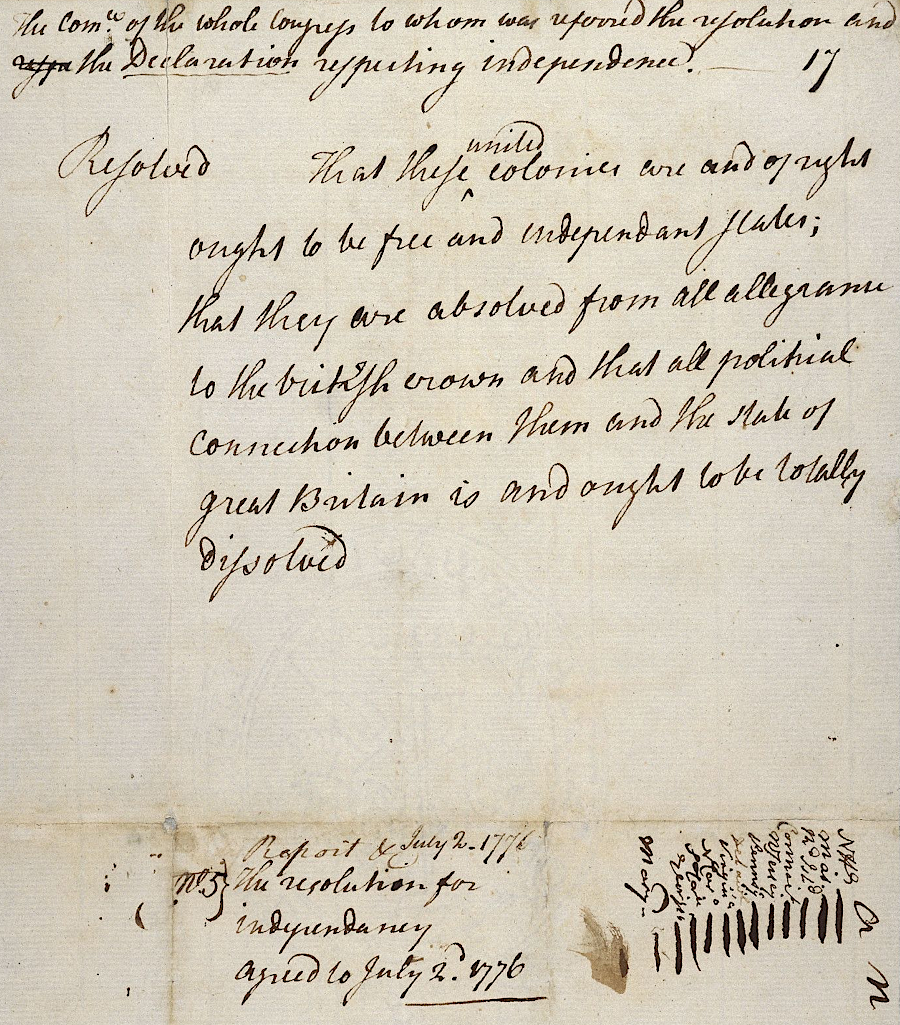
Richard Henry Le and other Virginians were leaders in the Continental Congress calling for independence, but the state experienced little damage from British troops until 1779
Source: National Archives, Lee Resolution (1776)
Except for naval raids, there were no British troops in Virginia for nearly three years after Lord Dunmore sailed away from Gwynn's Island in July 1776. The army returned during a raid in May, 1779 led by Commodore George Collier and Major General Edward Mathew. They destroyed the Gosport Shipyard at Portsmouth, but that attack was followed by another British abandonment after just two weeks.
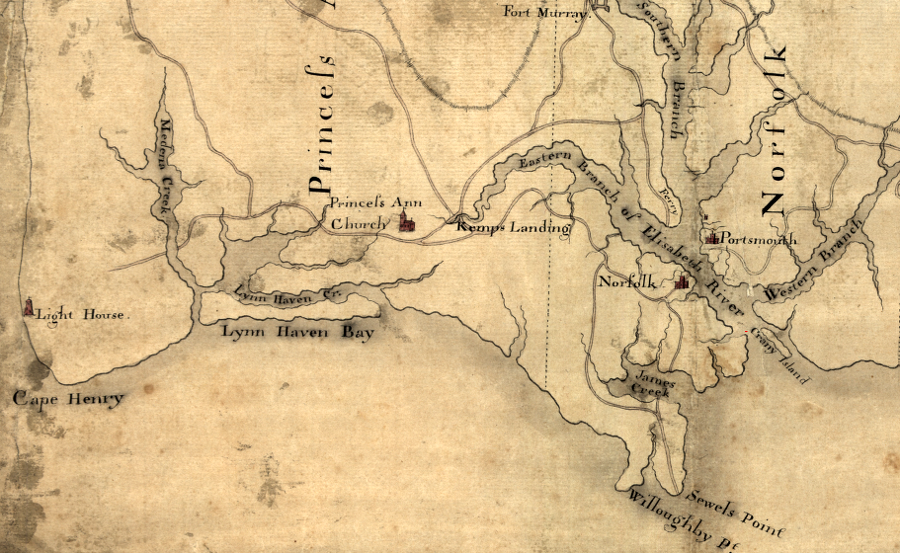
the British captured the Gosport Shipyard at Portsmouth and burned it in 1779
Source: Library of Congress, Part of the Province of Virginia (1791)
On September 23, 1780, volunteers and members of the militia mustered together in Abingdon. They marched south the next day, joining others in the Overmountain Men to cross the Blue Ridge and fight the British Army moving north from Charleston. On October 7, the Americans defeated British Major Patrick Ferguson and his Loyalist militia at Kings Mountain. That battle was the first to disrupt the southern strategy of the British.
Following the defeat, American militia expanded their control of the Carolinas. Loyalist militia were unable to resist outside of areas where British troops were stationed. To protect the Ninety Six region and the backcountry of South Carolina, Cornwallis moved from Charlotte to Winnsboro, South Carolina for the winter of 1780-81.4

the Overmountain Men started marching towards Kings Mountain after mustering in Abingdon, so the modern Overmountain Trail starts there
Source: National Park Service, Southern Campaign of the American Revolution Parks in South Carolina
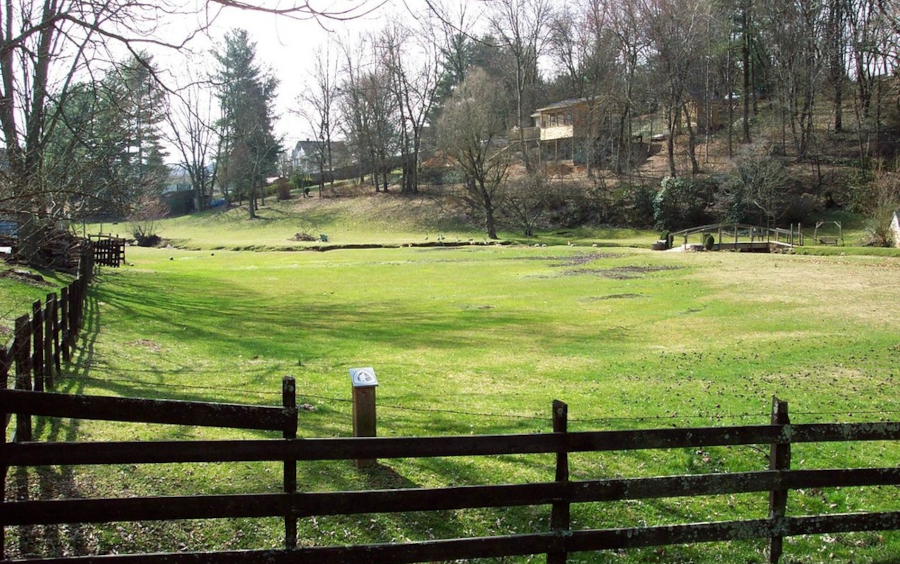
Southwest Virginians mustered at Abingdon in September, 1780 and marched across the Blue Ridge as part of the Overmountain Men
Source: National Park Service, Abingdon Muster Grounds
Major General Alexander Leslie arrived in Hampon Roads with over 2,000 troops in October, 1780. He was to support Lord Cornwallis's campaign in the Carolinas by disrupting the delivery of supplies that were leaving Virginia to support the Southern Army. Leslie left for Charles Town after only a month in Hampton Roads. After the defeat of loyalists led by Patrick Ferguson at King's Mountain, Cornwallis decided not to go into winter camp rather than march into North Carolina. Thomas Jefferson anticipated Leslie's withdrawal when he wrote to George Washington on November 3, 1780:5
General Benedict Arnold returned to Hampton Roads at the end of December, 1780. Arnold established his base at Portsmouth, and it remained the only place under continued British control until August 1781. As British troops led by Arnold, General William Phllips, and Lord Cornwallis marched across Virginia in 1781, they stayed in one place only briefly. As in the Carolinas, loyalists in Virginia who showed support for the invading army were exposed to retaliation as soon as King George III's troops moved away.
Between January 1-3, British troops sailed up the James River and raided plantations. General Arnold reached Richmond and occupied the city on January 4, 1781. The 200 militia defending the city withdrew after filing one ineffective volley. The British sacked the Virginia capital, then marched overland on the northern side of the James River back to Portsmouth. More plantations were raided on that march despite efforts of Virginia militia to harass the British in multiple skirmishes. Arnold returned to Portsmouth again on January 19.6
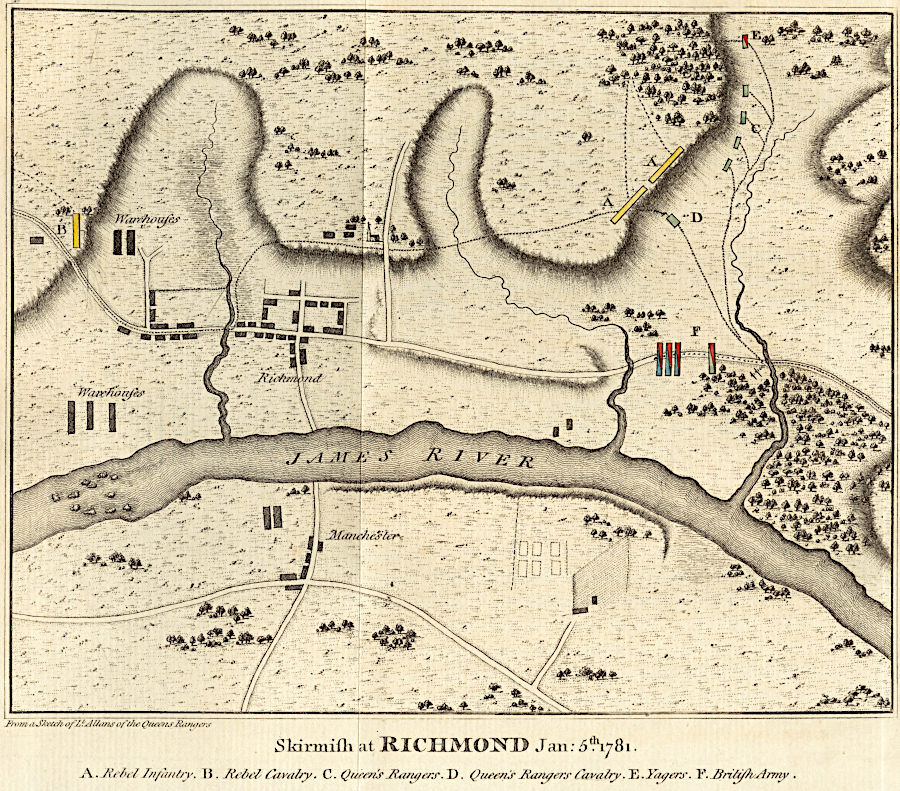
British forces under Benedict Arnold reached Richmond in January, 1781
Source: Leventhal Map Collection, Boston Public Library, Skirmish at Richmond Jan. 5th. 1781

American cannon and other supplies at Westham Iron Works were destroyed by Benedict Arnold in 1781
Source: National Archives, Virginia and the Chesapeake Bay: Sheet No. 13 Richmond (Civil War era map)
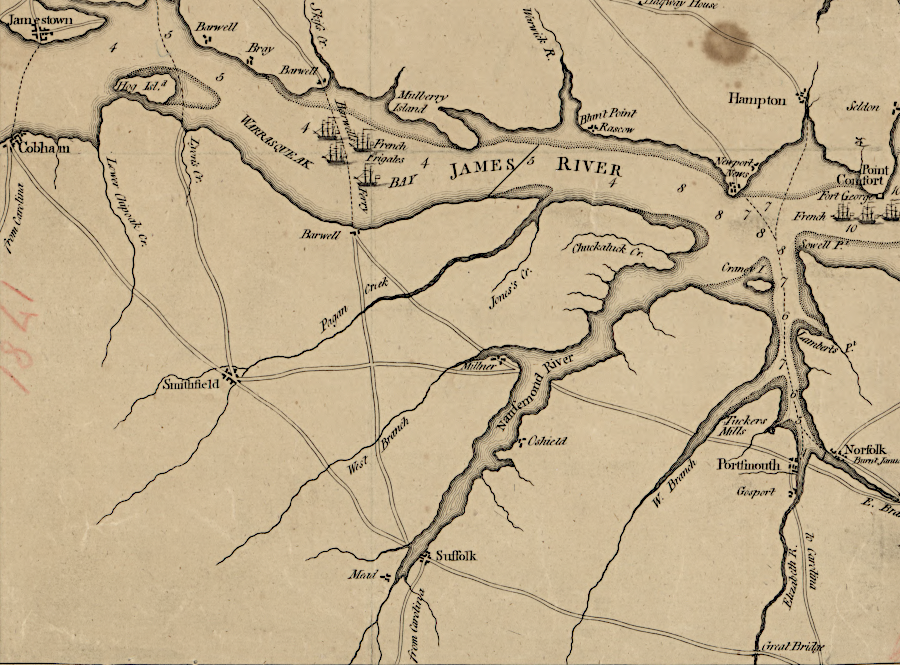
after raiding Richmond in January 1781, Benedict Arnold transported his troops down the James River to a spot 12 miles from Smithfield and marched to Portsmouth
Source: Library of Congress, A Plan of the entrance of Chesapeak Bay (by William Faden, 1781)
On February 22, 1781, General Arnold held a public assembly in Princess Anne County to get 400 local residents to swear a new oath of allegiance to the British government. They were willing to drink and eat what Arnold supplied for the event, and willing to mouth the words in the required oath, but they were just going through the motions.
Captain Johann Ewald, commanding Hessian forces, challenged one uncommitted Loyalist to raise troops locally in order to maintain control over the county. Ewald promised that the British would provide uniforms and weapons as needed. The Princess Anne resident replied to Ewald:7
Ewald replied initially, frustrated that his Hessians were risking their lives to assist the Loyalists unwilling to risk anything:8
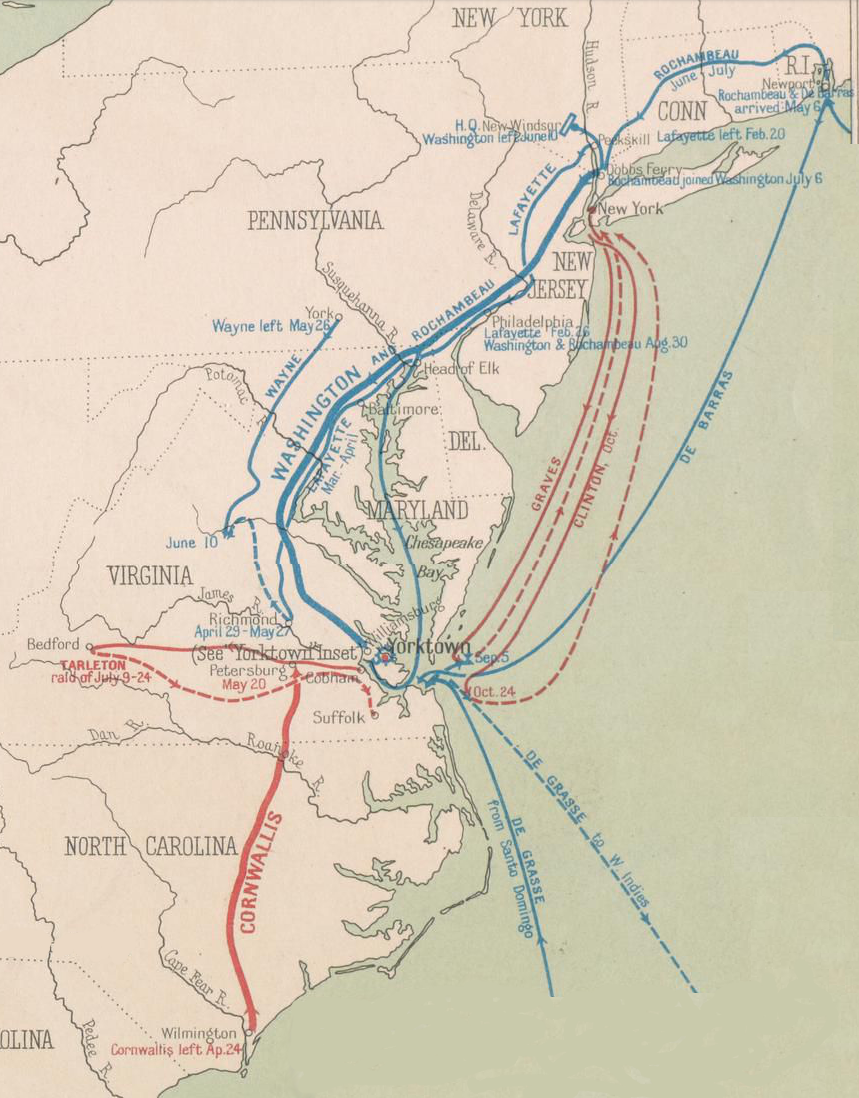
Cornwallis entered Virginia after crossing South Carolina and North Carolina, before choosing Yorktown as the deepwater port where he would be resupplied by ships of the Royal Navy sailing from New York
Source: Atlas of the Historical Geography of the United States, Campaigns of 1781 (Plate 160h, digitized by University of Richmond)
Later, Ewald recognized that Loyalists were wise to keep a low profile. He was surprised to discover that the responses he heard from loyalists were convincing and provided a clear rationale for not overtly supporting the British cause. The Marquis de Lafayette articulated the same perspective in a letter to the Continental Congress, which was alarmed that Cornwallis was marching through North Carolina into Virginia without meeting formal resistance:9

Lord Cornwallis chased General Nathaniel Green to the Dan River, before marching back into North Carolina and then fighting at Guilford Courthouse
Source: Library of Congress, The marches of Lord Cornwallis in the Southern Provinces (by William Faden, 1787)
On February 20, 1781 the Continental Congress directed the Pennsylvania Line to join the "Southern Army." Detachments needed to defend against Native America attacks were left in the western part of the state; George Washington sent orders for the rest to march to Virginia. The Pennsylvania Line had been disorderly, so he told General "Mad Athony" Wayne to arrive with the first units so a top commander could maintain discipline as different units reached Virginia.10
General William Phillips brought 2,000 more soldiers to Portsmouth from New York in March 1781, with directions by Sir Henry Clinton to take command from Benedict Arnold. Expanding the war effort in Virginia would reduce the number of troops who could be sent south from that state into the Carolinas, and interdict supplies which could support George Washington's army around New York.

British fleets seized Portsmouth in May 1779, October 1780, and January 1781
Source: Henry Beebee Carrington, Battles of the American Revolution, 1775-1781 (opposite p.595)
Phillips sailed out of Portsmouth on April 18, 1781. He seized Williamsburg, then destroyed the Virginia State Navy base on the Chickahominy River. He crossed the James River and landed at City Point, then captured Petersburg a day later in the Battle of Blandford on April 25. In that battle, 1,000 Virginia militia under General Baron von Steuben delayed the 2,500 British troops by a day. The militia retreated north across the Appomattox River to a ridge that became known as Colonial Heights. The delay gave Lafayette time to develop defenses around Richmond.

General Phillips moved from Portsmouth to the north side of the James River, then back across the river to capture Petersburg
Source: Library of Congress, Campagne en Virginie du Major Général M'is de LaFayette
The British then destroyed the barracks at Chesterfield Court House and captured ships and supplies at Osborne's Landing. General Phillips raided Richmond again. He chose to avoid Lafayette's defenses, but destroyed the cannon foundry at Westham upstream of the city.10

Benedict Arnold destroyed the Virginia State Navy at Osborne's Landing on April 27, 1781
Source: Norman G. Leventhal Map and Education Center, Boston Public Library, Sketch of the action at Osburns, April 27th. 1781d (by John G. Simccoe, 1787)
In April, Lieutenant General Charles Earl Cornwallis was in Wilmington, North Carolina, south of General Phillips. Cornwallis had marched north from Charleston, which the British had captured in May 1780. He had arrived at Wilmington after a series of battles across the Carolinas in which the English won most engagements other than Kings Mountain on October 7, 1780 and Cowpens on January 17, 1781. However, the British army always lost soldiers and no reinforcements arrived from Charleston or New York.
The battles drained Cornwallis' army without destroying the capacity of the Americans to maneuver in the Carolinas. General Nathanael Greene skillfully escaped being trapped as he retreated north from Cowpens. He raced for the Dan River.
In early February 1781, Cornwallis thought he was in position to block Greene from crossing the Dan River. The British and their Hessian allies were at what is now Winston-Salem; Greene was at what is now Greensboro about 20 miles to the east. To reach fords of the upper Dan River that were shallow enough for an army to cross, Greene needed to march north - where Cornwallis could intercept him and force a major battle.
However, his dragoons led by Col. Otho Williams, including cavalry commanded by "Lighthorse Henry" Lee, screened his movements and left the British unclear about the best opportunity to intercept him. The American army actually marched northeast, away from Cornwallis. Greene had his men collect all the boats along the Dan River and successfully ferried his army across the river at Irvin's Ferry and Boyd's Ferry. The Americans won the three week, 250-mile "Race to the Dan," but by just 12 hours after heavy marching by both sides:11

Nathaniel Greene's army moved northeast, away from Cornwallis, and won the "Race to the Dan"
Source: National Park Service, An accurate map of North and South Carolina
He camped at what is now South Boston, keeping all the boats on the north bank of the river so Cornwallis could not reach him. After resupply, he then headed south to challenge Cornwallis. The battle fought at Guilford Courthouse on March 14, 1781, was technically a British victory because the American army had retreat from the battlefield, but it was a Pyrrhic victory; British losses were significant.
The British general chose to march east to the North Carolina port city of Wilmington in order to resupply. Wilmington was under British control in 1781, along with three other ports at Savannah, Charleston, Portsmouth and New York. The Royal Navy could bring food, weapons, gunpowder, clothing, and other equipment needed for an effective fighting force to win a battle against what could be larger number of Virginia and North Carolina militia, supported by some Continental regulars.
Marching south from Wilmington to Charles Town would protect the loyalist outpost at Camden that was threatened by General Greene. However, Cornwallis concluded that his army was too small to conquer and hold North Carolina, especially since so few loyalists were willing to fight. Cornwallis gambled that there were enough British allies in South Carolina to control territory once the British Army marched away - but he recognized that was not true in North Carolina.
Taking the British Army into the North Carolina Piedmont also created the risk of getting trapped between major rivers without hope of supply by the Royal Navy, since the rivers were not navigable except near the Atlantic Ocean.
Cornwallis preferred to wage offensive rather than defensive warfare. By marching into Virginia, Cornwallis might create the opportunity to fight Continental Army units and Virginia militia in standard battles.
He did not desire to return to South Carolina, where the brutality of the loyalists and patriots fighting a civil war was appalling. There was no potential for glory or satisfaction in a war of attrition, where the leaders of those who surrendered often were hung by the opposing side rather than kept as prisoners.
The potential for Cornwallis' small army to conquer Virginia and establish a Loyalist government there was thin, but at least he could stay on the offensive there and be supplied near the rivers. After his expected victories, captured territory could be restored to royal government in Virginia - assuming enough loyalists could be found to retain control and restore civil government.
Cornwallis eventually calculated that British forces remaining at Camden, Ninety-Six and Augusta would be in a stronger position to hold their territory if military actions in Virginia cut off the supply of rebel troops and supplies flowing into the Carolinas.
Cornwallis marched north from Wilmington, leaving on April 25, 1781. His superior, Sir Henry Clinton in New York, had directed him to suppress the rebellion in South Carolina while General William Phillips would assist in Virginia by interrupting supplies headed south. Clinton planned to withdraw troops from the disruption efforts in Virginia to reinforce his army in New York, where he expected the French to strike.
Cornwallis did not seek permission from Clinton to ignore his orders; he simply notified the Commander-in-Chief as well as General William Phillips that he was moving north into Virginia. Cornwallis did share with Phillips his pessimism regarding the likelihood of either military or political success in Virginia:12
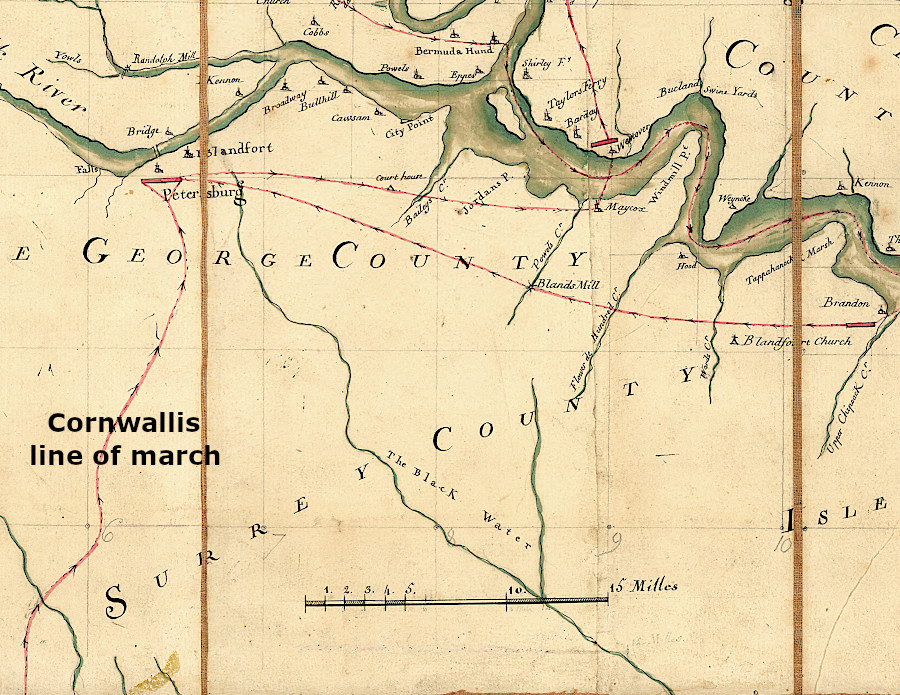

in 1781, Cornwallis left North Carolina to meet General William Phillips in Petersburg
Source: Library of Congress, Campagne en Virginie du Major General M'is de LaFayette : ou se trouvent les camps et marches, ainsy que ceux du Lieutenant General Lord Cornwallis en 1781
Source: Library of Congress, The marches of Lord Cornwallis in the Southern Provinces (by William Faden, 1787)
Phillips went to Petersburg in expectation of meeting Cornwallis there, but died from malaria or typhus before Cornwallis arrived. General Phillips' body was buried secretly in the cemetery at Blandford Church; the exact location is still unknown.
After arriving in Petersburg, Cornwallis sidelined Benedict Arnold by sending him back to New York. Col. Banastre Tarleton, in his 1787 memoirs, diplomatically described Cornwallis' removal of a person he did not want in his army:13
The British forces moved from Petersburg towards Richmond, seeking to defeat the Marquis de Lafayette before he could unite with the Pennsylvania Line coming to reinforce him. Between May-September 1781, the British had complete military dominance in Virginia thanks to their superior numbers (over 7,000 men) and especially their cavalry. Lafayette had only a few men on horses and struggled to have enough cavalry to monitor the movements of Cornwallis' forces.

Col. Banastre Tarleton seized the ships and supplies at Osborne's Landing on April 27, 1781
Source: Huntington Library, Journal of the operations of the Queen's Rangers (Colonel John Simcoe, 1782)

May 24, 1781, Cornwallis marched from Petersburg to Maycox plantation, then crossed the James River to Westover
Source: Library of Congress, A map of the most inhabited part of Virginia
Cornwallis did not take the direct route from Petersburg to Richmond. He did send ___ to destroy the barracks that housed recruits for the Continental Army and supplies at Chesterfield Court House. ___ was sent to Osbourne's Landing to destroy the ships of the Virginia Navy that were anchored there.

on May 24, 1781 Cornwallis marched from Petersburg to Maycox plantation in King George County and then crossed James River to Westover plantation
Source: Library of Congress, Campagne en Virginie du Major Général M'is de LaFayette
As Cornewallis approached Richmond, the rebellious Virginia leaders in the General Assembly fled on May 10. They headed west to reconvene on May 24 in Charlottesville. A quorum of members finally assembled on May 28, when the legislature reconvened in (probably) Scottsville at the former Albemarle County Courthouse. <./p>
Jefferson's second one-year term expired at the start of June and he had declined to serve any longer, but the legislature was too busy with other issues to elect his replacement on May 28. Not until June 12 was _____ Nelson elected as Virginia's third governor. By then the General Assembly had fled another 40 miles away, and was gathered inside the Anglican church at Staunton.14
Cornwallis decided that he could not cross the North Anna River and catch Lafayette before General "Mad" Anthony Wayne would arrive with the Pennsylvania reinforcements. Cornwallis also decided that the supplies stored by the Virginians at two locations to his west were more significant that the material at Fredericksburg and Hunter's Iron Works at Falmouth.

Cornwallis marched from Petersburg to the North Anna River (yellow line), while Lafayette avoided any engagement in which his force of Continentals and Virginia militia might be destroyed
Source: Norman B. Leventhal Map & Education Center, Boston Public Library, March of the Army under Lieut:t General Earl Cornwallis in Virgini, from the Junction at Petersburg on the 20.th of May, til their arrival at Portsmouth on the 12.th of July 1781

Cornwallis stopped at the North Anna River, and decided not to march to Fredericksburg in order to destroy Hunter's Iron Works
Source: Norman B. Leventhal Map & Education Center, Boston Public Library, March of the Army under Lieut:t General Earl Cornwallis in Virgini, from the Junction at Petersburg on the 20.th of May, til their arrival at Portsmouth on the 12.th of July 1781
Taking advantage of Lafayette being on the other side of the North Anna River, Cornwallis split his army. He sent Colonel John Simcoe and his Queens Rangers to seize an important supply base at the mouth of the Rivanna River, ordered Col. Banastre Tarleton to race west from Hanover Court House to Charlottesville, and marched with the rest to a planned reunion at Thomas Jefferson's Elk Hill plantation in Goochland County.
At Point of Fork (the site of the old Monacan town of Rassawek, near modern-day Columbia), Baron von Steuben moved all the supplies and boats away from Colonel John Simcoe to the south side of the James River. Von Steuben was fooled into thinking all of Cornwallis' army had arrived, and the American rebels fled. The British were able to cross the river unopposed and destroy the stockpile.15
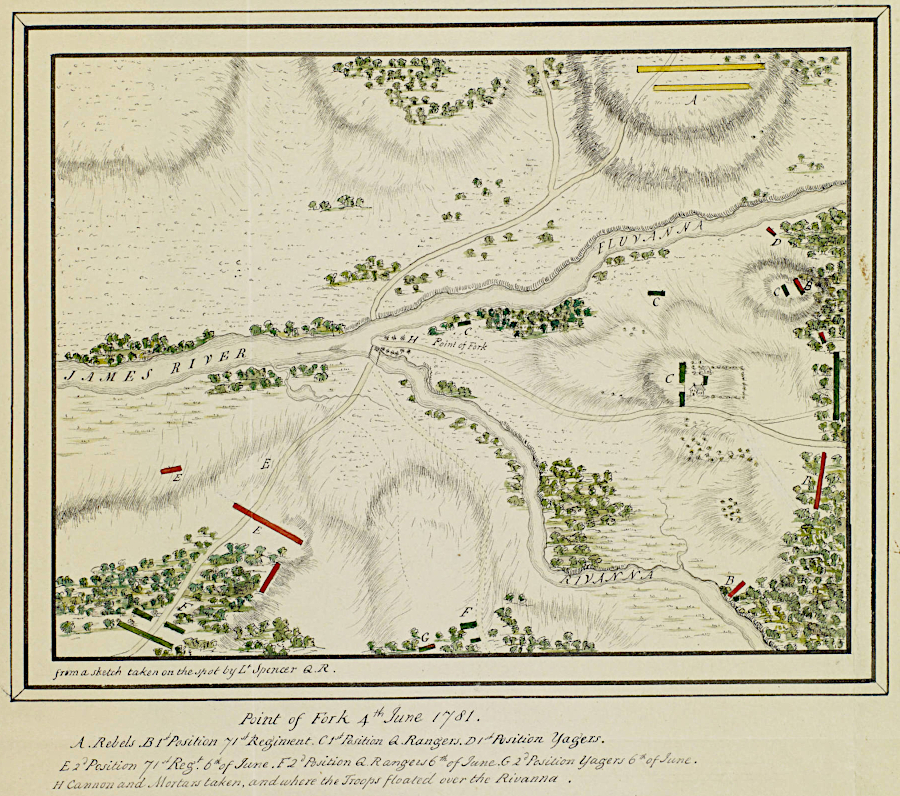
under Colonel John Simcoe, the Queen's Rangers (American Tories) captured Baron von Steuben's supply base at Point of Fork (modern-day Columbia) on June 5, 1781
Source: Huntington Library, Journal of the operations of the Queen's Rangers (Colonel John Simcoe, 1782)
Col. Banastre Tarleton led a raid to Charlottesville with his British Legion to destroy supplies there and also to capture the General Assembly. As British cavalry were riding up the hill at Monticello on June 4, Thomas Jefferson fled in the other direction. He retired to property he owned in Bedford County where he later constructed Poplar Forest.
Opponents, primarily supporters of Patrick Henry, quickly accused Jefferson of mismanaging the Virginia response to the invasions by Arnold, Phillips, and Cornwallis, and of personal cowardice for his flight. Jefferson responded that the state always lacked the resources to counter the British, particularly a navy to stop them from crossing rivers:16
The legislators who escaped Tarleton went further west to Staunton and reassembled in Trinity Church. While meeting in Staunton, the General Assembly elected Thomas Nelson Jr. as the next governor.17

Cornwallis split his army at the North Anna River to launch raids on Charlottesville and Point of Fork, while he marched (yellow line) to Thomas Jefferson's Elk Hill plantation
Source: British Library, MARCH of the ARMY under Lieut:t General EARL CORNWALLIS in VIRGINIA, from the JUNCTION at Petersburg on the 20.th of May, til their arrival at Portsmouth on the 12.th of July 1781
After being rejoined by Simcoe and Tarleton, Cornwallis marched his army east from Elk Hill back to Williamsburg. There he receive a message from Gen. Henry Clinton in New York, who feared attack by the combined forces under General George Washington and the French under the Count de Rochambeau. Clinton demanded Cornwallis detach a force from his unchallenged marches through Virginia and send them to New York. To supply the troops and to ensure adequate fortifications to protect his remaining force, Cornwallis started to move to the British base at Portsmouth.
That required crossing the James River again. The British Navy brought up ships, and the army moved to Jamestown Island in order to be ferried across to Cobham.
That is where Lafayette finally sent Wayne's troops to attack Cornwallis. Lafayette thought he was dealing with only the rear guard because Tarleton had arranged for him to capture a false deserter with that "intelligence," but Cornwallis had disguised his movements and outnumbered the Americans. Wayne managed to retreat back to Green Spring Plantation, the former home of Governor Culpeper. The British victory at Green Spring was the largest infantry engagement to occur in Virginia during the American Revolutionary War.18
After crossing to the south bank, Tarleton was sent west to Bedford County to interdict and destroy supplies intended for the General Greene's army in the Carolinas. The British Legion left Cobham on July 9, 1781, passing through Petersburg and Prince Edward Courthouse (now Worsham, near Hamden-Sydney college south of Farmville). During the raid, the cavalry rested in the middle of the day to avoid exhausting the horses.
British intelligence was faulty; the American supplies had been shipped to the Carolinas a month earlier. Tarleton chose a different route back to reach Portsmouth, since General Wayne had moved his units to Petersburg. Fortunately for the British, no Americans contested their crossing over the Blackwater River, where a defended position could have blocked the ford.
Over the course of 15 days, the cavalry rode over 400 miles. There were no significant engagements, and few supplies were destroyed. Fine Virginia horses were captured, but Tarleton later judged that the British had been more damaged by the long, hot ride than the Virginians:19
One of the tall tales of the Revolutionary Way is of the superhuman strength of Peter Francisco. He was an impressively-large man, perhaps 6'6" tall. Supposedly he single-handedly pulled an 1,100 pound cannon off its carriage and brought it safely to a wagon during the battle of Camden.
During Tarleton's Bedford raid, nine of Tarleton's cavalry made Francisco their prisoner. When one demanded that he hand over the silver buckles on his shoes, Francisco reportedly grabbed the soldier's sword, wounded him, and forced the other eight to flee while leaving their horses behind.
Perhaps the most accurate element of the story is the behavior of the tavern keeper. Francisco reported that he helped the British by giving one a gun to shoot Francisco. The tavern keeper was a loyalist, for at least that moment. Not all Virginians were strong supporters of a revolution, especially when surrounded by British troops.20
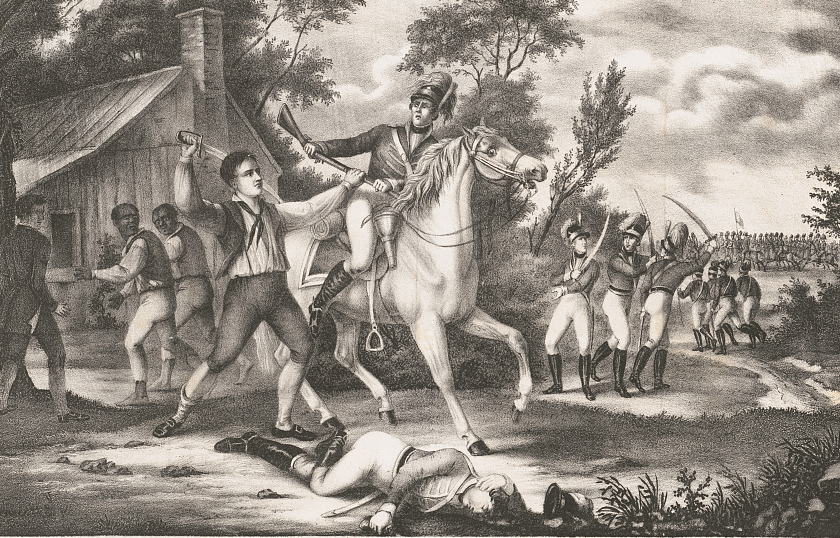
Peter Francisco, an unusually strong and courageous man, became an American hero for his fighting against the British
Source: Library of Congress, Peter Francisco's gallant action with nine of Tarleton's cavalry in sight of a troop of four hundred men
After Tarleton left on the Bedford raid, Cornwallis took the rest of his army along the path of modern Route 10 to Suffolk and on to Portsmouth.

Cornwallis unloaded his troops at Cobham and marched to Portsmouth, anticipating General Clinton would send reinforcements there from New York City
Source: Norman B. Leventhal Map & Education Center, Boston Public Library, March of the Army under Lieut:t General Earl Cornwallis in Virgini, from the Junction at Petersburg on the 20.th of May, til their arrival at Portsmouth on the 12.th of July 1781
He received new orders directing him to stay north of the James River and to secure Old Point Comfort as a base for the British Navy. After determining it was not the best place to establish a base and wait for resupply from New York, he moved the British Army by ship to Yorktown in August, 1781. The British destroyed the fortifications at Portsmouth to prevent them from being used by Lafayette.21
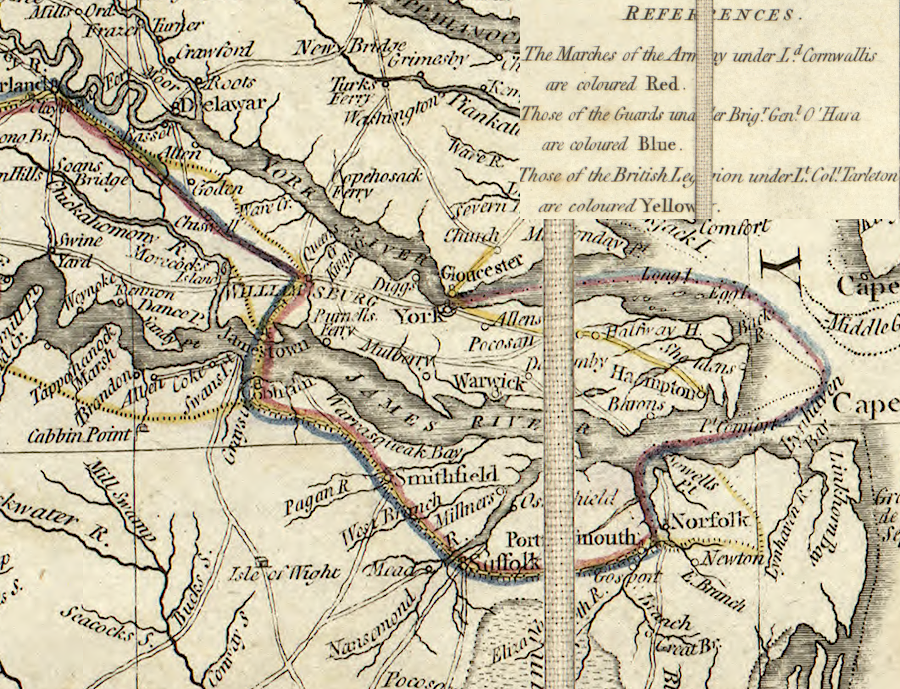
the British sailed from Portsmouth to Yorktown in August, 1781 in anticipation of getting resupplied there
Source: Library of Congress, The marches of Lord Cornwallis in the Southern Provinces (by William Faden, 1787)
The ultimate fate of the British army at Yorktown was determined by a naval battle in the Atlantic Ocean. At the Battle of the Capes, a French fleet blocked the British ships coming from New York from entering the Chesapeake Bay. When Washington and Rochambeau arrived with American and French troops, Cornwallis was trapped in Yorktown without the expected reinforcements or supplies.
His surrender to a united force of French and American troops in October, 1781, was a catastrophe for the enslaved men and women who had chosen to abandon their Virginia homes and follow the British. During the four months of marching across the state, Cornwallis encouraged enslaved people to leave their masters and follow him. Cornwallis learned from his Carolina experience, and did not expect Virginia's Tories to re-establish control and govern after his army had moved on. He did not try to win the hearts and minds of white Virginians by returning slaves. Instead, he sought to impose economic pain on the rebels and force the colony into submission, and to the enslaved population "freedom wore a red coat" in 1781.
After Cornwallis surrendered, George Washington ordered that the free blacks within the British lines be separated from the enslaved blacks. Those who were judged to be escaped slaves were returned to their masters.22
Yorktown brought most, but not all, fighting to an end. In North Carolina, loyalist David Fanning led the "Bloody Sabbath" raid in March, 1782. Three of the revolutionary leaders in Randolph County, south of Greensboro, were murdered and the estates of four others were plundered. The civil war between Americans continued without the British.23
Josh Wheeler, "The Complicated History of David Fanning's Murderous 1782 Bloody Sabbath Raid, Journal of the American Revolution, July 22, 2025, https://allthingsliberty.com/2025/07/the-complicated-history-of-david-fannings-murderous-1782-bloody-sabbath-raid/ (last checked August 5, 2025)
On the western frontier, British officers worked with Native Americans to launch two major assaults in 1782.
On August 19, 1782, 50 British soldiers and 300 Native Americans clashed with 182 Kentucky militiamen at the Battle of Blue Licks in Kentucky. The Americans had been pursuing the British/Native American force which had attacked Bryan's Station and, after failing to capture it, headed north to cross the Ohio River.
Daniel Boone warned the Kentucky militia that they were following a too-obvious trail, and an ambush lay ahead. Other leaders chased on anyway, to avoid accusations of cowardice. Boone followed, commenting:23
Boone was correct. About 1/3 of the Kentuckians - including Boone's son Israel - died that day.24
In the other assault by British rangers and Native American warriors, Fort Henry was surrounded in September, 1782. The defenders inside the fort at Wheeling were just the local residents, who raced inside just before the raiders appeared. A few other Virginians, including the family of Ebenezer Zane, fled to the nearby blockhouse where the gunpowder was stored.
The fort's defenders repelled two attacks on the first night, but ran low on gunpowder by morning. Elizabeth Zane ran from the fort to the blockhouse, filled her apron with gunpowder, and raced back to the fort under fire from the attackers. That enabled the defenders to continue their resistance. The attackers had brought only enough supplies for a few days, and soon abandoned the siege.25
The American retaliation came in November, 1782. George Rogers Clark led an army into Ohio and burned five Shawnee villages, in the Northwest Territory to which Virginia had only recently ceded its claims to the Continental Congress. The Shawnee retreated rather than fight, but the expedition is often described as the "last battle" of the American Revolution.26
It took four months for the defeat of Cornwallis at Yorktown to finally convince Parliament that the war in North American could not end in a British victory, with restoration of the colonies as subservient to London officials. Three times Parliament voted on ending the war.
On December 12, 1781, a motion to end the war was defeated by a 220-179 vote. Another vote on February 22, 1782 ended with a majority still in support of continuing hostilities, but the vote was 194-193. Five days later, with 65 more members of Parliament in attendance, the decision to end the war was adopted by a 234-215 vote.
Negotiating a treaty took 18 more months. The Treaty of Paris, which ended the war and acknowledged American independence, was signed on September 3, 1783. Article Seven said:27
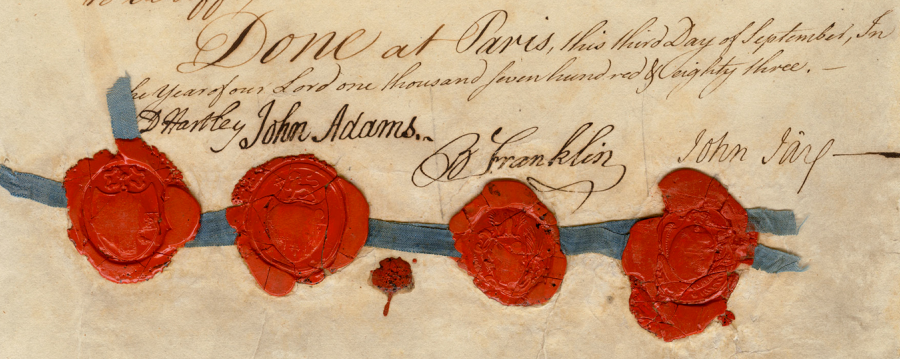
John Adams, Benjamin Franklin, and John Jay signed the Treaty of Paris, which ended the Revolutionary War in 1783
Source: Iowa Historical Society, Treaty of Paris
By the end of the war, the death toll from disease was far greater than from actual fighting. According to historian Woody Holton:28 "Fighting The American Revolution: An Interview With Woody Holton," Age of Revolutions, April 11, 2022, https://ageofrevolutions.com/2022/04/11/fighting-the-american-revolution-an-interview-with-woody-holton/ (last checked April 13, 2022)
A detailed 1774 study identified 25,534 American combatants who died in the American Revolution. Of that total, 8,624 (27%) died in one of the 1,331 land engagements and 215 naval engagements rather than from disease. About 10,000 Continental Army/militia soldiers died while in camp or marching, and about 8,500 men died while imprisoned by the British. The prison ships were "petri dishes of disease."
The American death toll, including those who served in state militias, was 1% of the population. That would be equivalent today of over 3,000,000 deaths.
Roughly 24,000 British soldiers died, plus 7,500 of the hired Germans. The American Battlefield Trust calculates that of the 30,000 German troops who arrived over the course of the war in North America, 1,200 were killed in battle. Another 6,354 died of disease and 5,500 deserted. According to the American Battlefield Trust:29
"How Many Died in the Revolutionary War?," History.com, September 12, 2023, https://www.history.com/articles/revolutionary-war-deaths; "American Revolution Facts," American Battlefield Trust, https://www.battlefields.org/learn/articles/american-revolution-faqs (last checked July 13, 2025)
Source: American Battlefield Trust, The Revolutionary War in the North: Animated Battle Map
Source: American Battlefield Trust, The Revolutionary War in the South: Animated Battle Map

in 1781, Lafayette (yellow line) could only shadow the British (red line) as they chose to raid Richmond and destroy supplies throughout Virginia
Source: Library of Congress, Campagne en Virginie du Major General M'is de LaFayette : ou se trouvent les camps et marches, ainsy que ceux du Lieutenant General Lord Cornwallis en 1781

Cornwallis concentrated forces at Petersburg in April 1781, crossed the James River to Westover Plantation and captured Richmond, then embarked at Bermuda Hundred to sail back to the British base at Portsmouth
Source: Library of Congress, Campagne en Virginie du Major General M'is de LaFayette : ou se trouvent les camps et marches, ainsy que ceux du Lieutenant General Lord Cornwallis en 1781

after an American victory at Cowpens, General Daniel Morgan and General Nathaniel Greene managed a strategic retreat across the Carolinas and crossed the Dan River before General Cornwallis
Source: Internet Archive, A School History of the United States, from the Discovery of America to the Year 1878 (p.196)
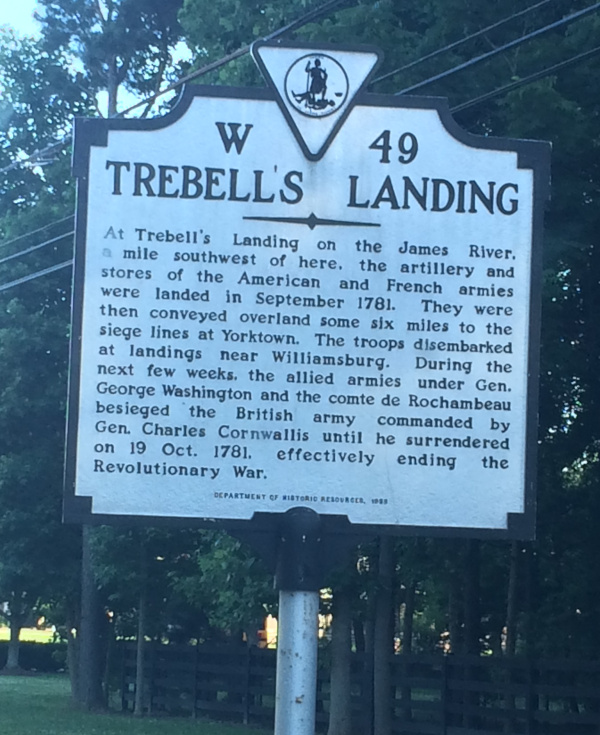
highway historical markers highlight Revolutionary War events in eastern Virginia
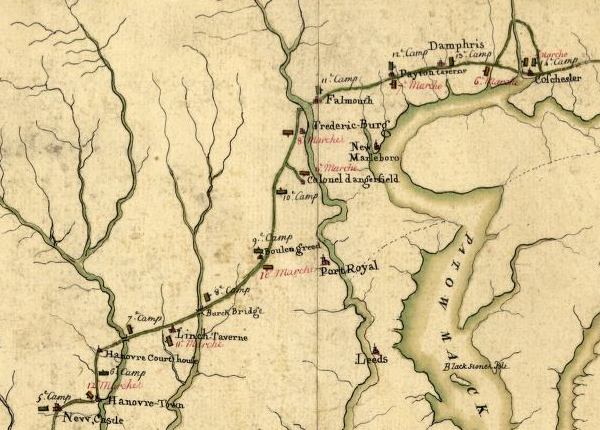
route of Comte de Rochambeau's army through Northern Virginia, 1781 and 1782
Source: Library of Congress, Cote de York-town - Boston: Marches de l'armee
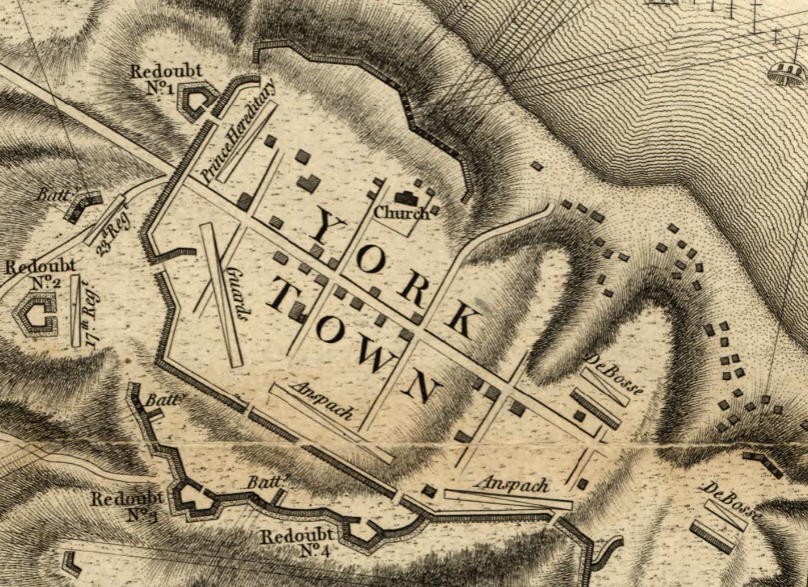
Lord Cornwallis fortified Yorktown, with the expectation that reinforcements would arrive from New York before his base could be captured through a siege by French and America armies
Source: Library of Congress, Plan of Yorktown and Glucester [sic], Virginia, October 1781
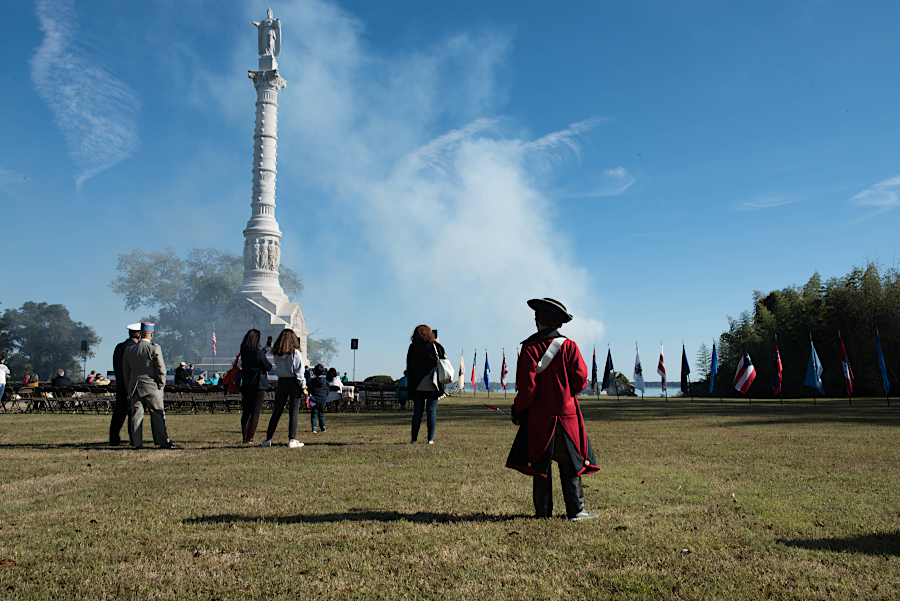
re-enactors at the Yorktown Victory Monument
Source: Joint Base Langley-Eustis

most military activity in Virginia occurred in 1780-81, after Cornwallis moved north from Charleston
Source: Library of Congress, The comprehensive series, historical-geographical maps of the United States (1919)

the Continental Congress was responsible for uniforms and other supplies needed by soldiers in the Continental Army
Source: Library of Congress, Infantry: Continental Army, 1779-1783 (by Henry Alexander Ogden, 1897)
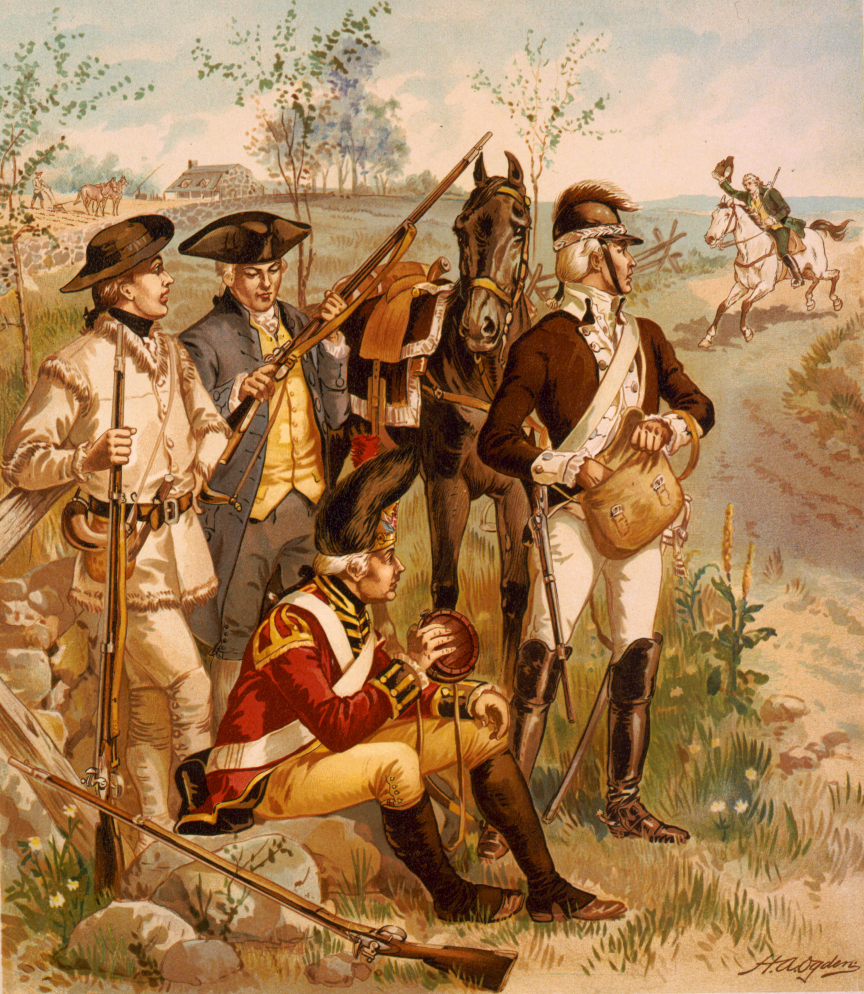
units not in the Continental Army chose their own form of dress
Source: Library of Congress, Independent company organizations (by Henry Alexander Ogden, c.1891)
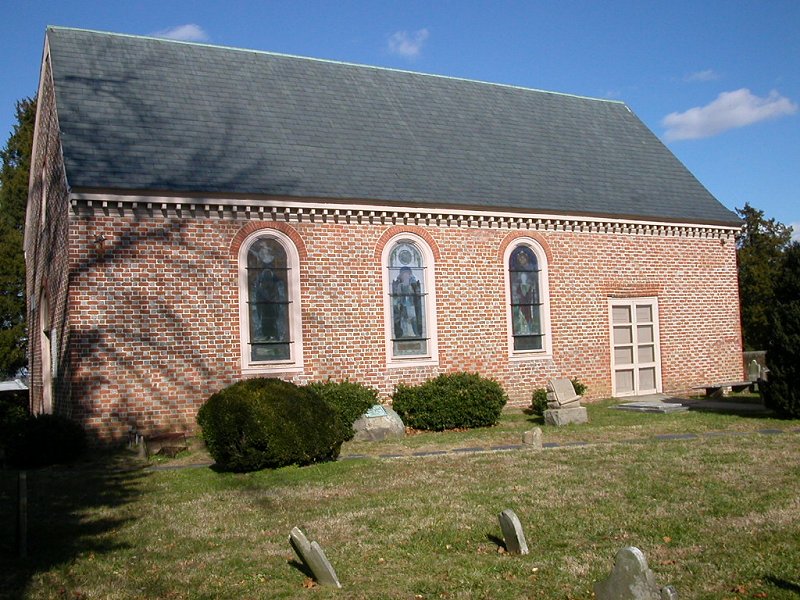
Blandford Church in Petersburg - burial site of Major General William Phillips, who captured the city in 1781

in 1781, Col. Banastre Tarleton raided as far west as Bedford and Charlottesville and Lord Cornwallis marched up to the North Anna River
Source: Library of Congress, The marches of Lord Cornwallis in the Southern Provinces (by William Faden, 1787)

Bedford was not safe from the British in 1781
Source: Library of Congress, The marches of Lord Cornwallis in the Southern Provinces (by William Faden, 1787)

French cannon at Yorktown
Source: National Park Service, Sidney King Painting

two French fleets blocked reinforcements from reaching Lord Cornwallis at Yorktown in 1781
Source: Library of Congress, A Plan of the entrance of Chesapeak Bay (by William Faden, 1781)
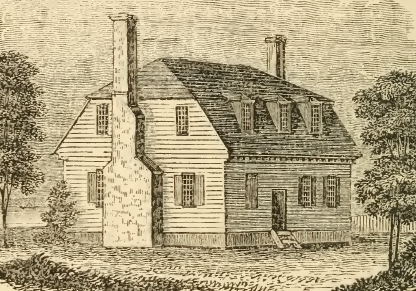
Cornwallis's surrender in 1781 was negotiated in the Moore House outside the town of Yorktown by subordinates - Cornwallis and Washington did not meet there in person to sign terms of capitulation
Source: Historical collections of Virginia, The Moore House, Yorktown (p.530)
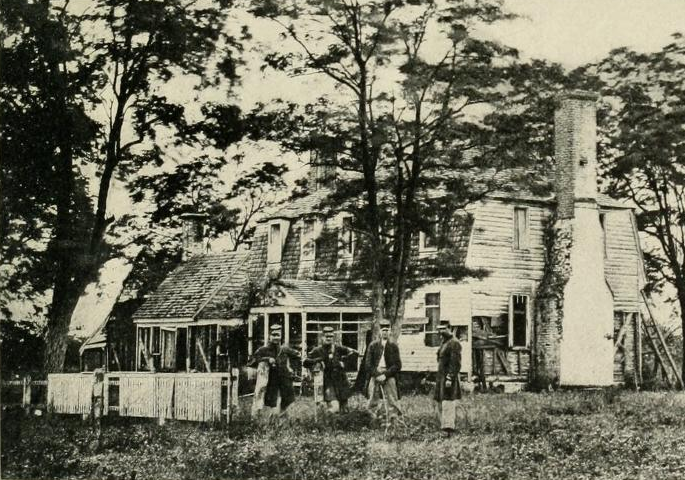
the Moore House in Yorktown was damaged during the Civil War
Source: The Photographic History of the Civil War, The Scene of Yorktown's Only Surrender (p.268)
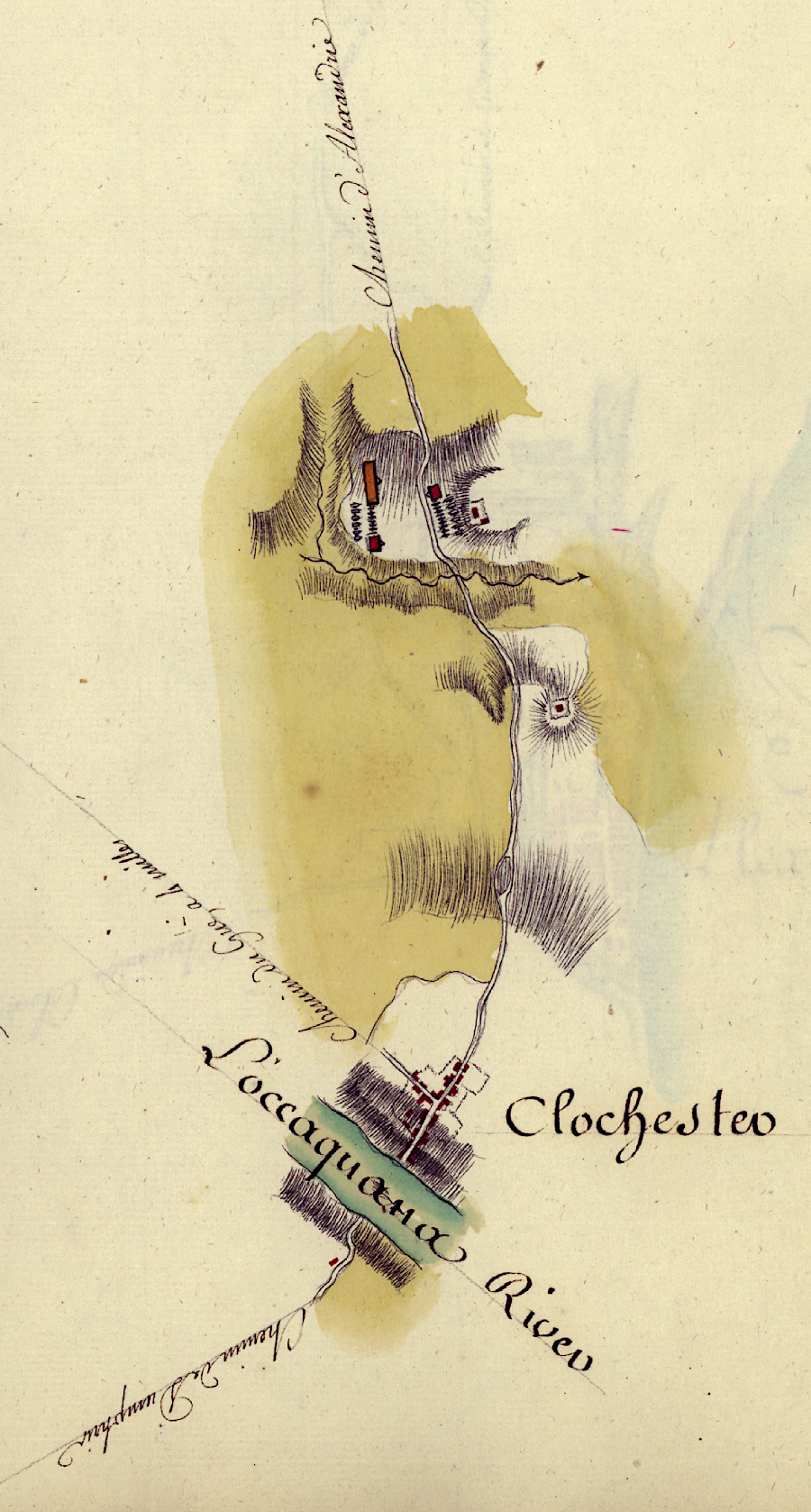
the French army marched through Fairfax County in 1781 towards Yorktown, and camped there again in 1782 when headed back north
Source: Library of Congress, Amérique campagne. - Camp a Colchester (Rochambeau Map Collection, 1782)
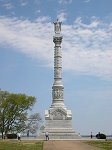 Yorktown Victory Monument |
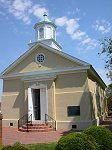 Yorktown Grace Church |
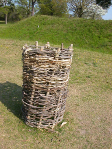 Yorktown fascine (1781 sand bag) |
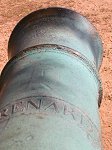 Yorktown "Fox" cannon |
 NPS visitor center (Yorktown Battlefield) |
 Thomas Nelson house (Yorktown) |
 Nelson House 1781 cannonball (fake...) |
 Yorktown mural (Read Street) |
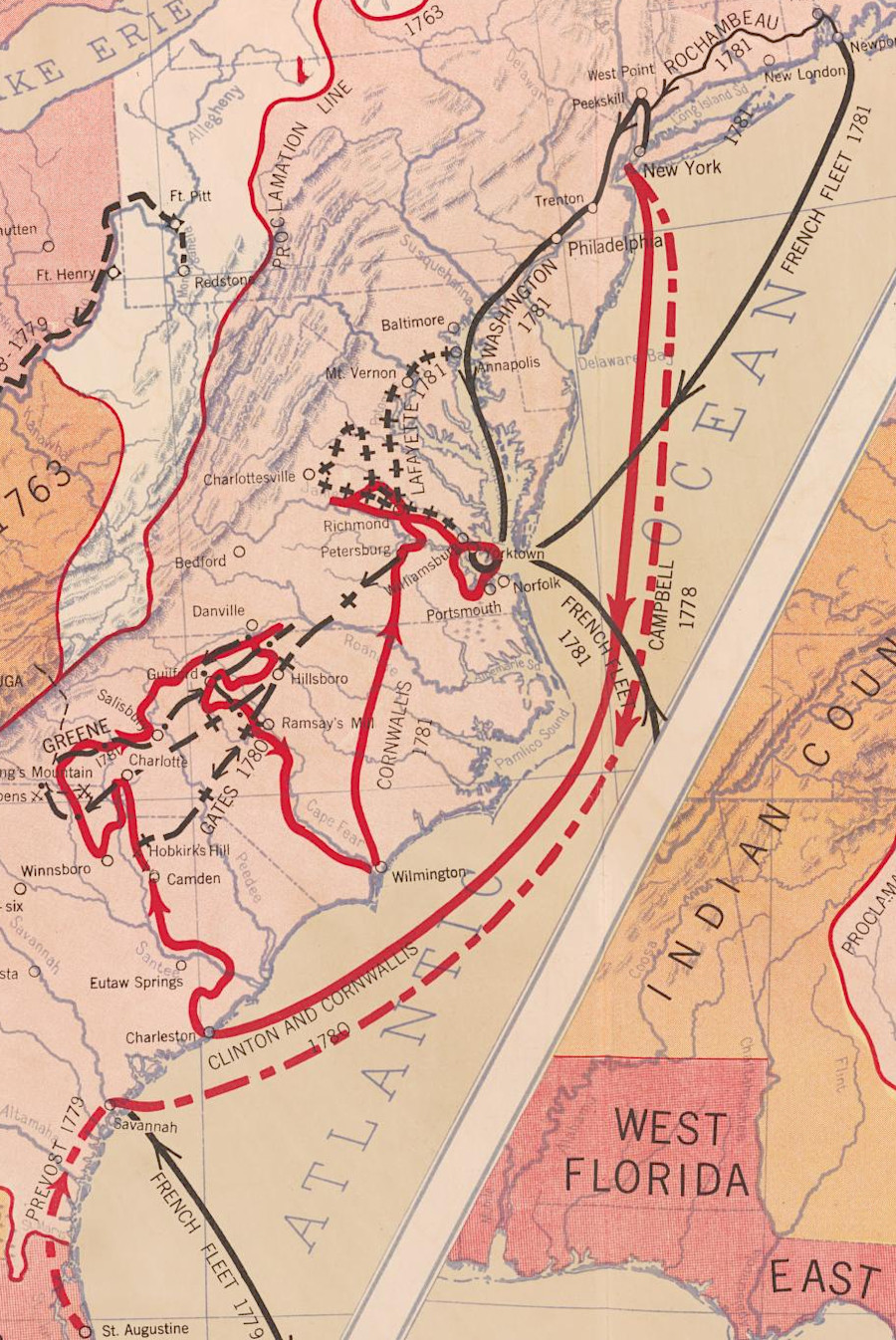
Cornwallis (red line) marched up from Charleston and across much of Virginia in 1781 before reaching Yorktown
Source: Library of Congress, Revolutionary War, 1775-1783 (Hart-Bolton American history maps, 1917)
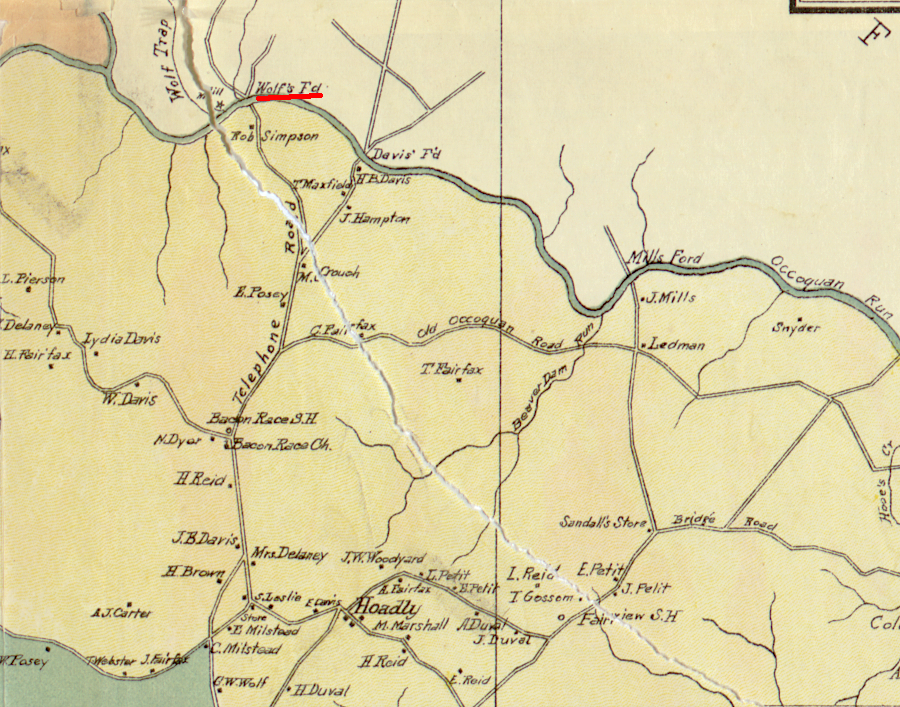
the road south of Wolf's Ford, where French artillery crossed the Occoquan River in 1781, was known as Telephone Road in 1901
Source: Library of Congress, Map of northern Virginia (1894); Map of Prince William County, Virginia